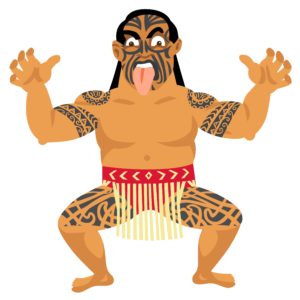
For most viewers in America, Jason Momoa’s haka dance with his fellow cast members at the recent Los Angeles Aquaman premiere was a viral moment. As seen in the video accompanying Vincent Schilling’s Indian Country Today report, this dance is vibrant and full of energy. Yet what exactly is the haka, and what does it represent? To comprehend its importance to Māori people worldwide, one must learn about its cultural and spiritual significance.
New Zealand’s First People
The Māori are New Zealand’s oldest human civilization. Travel writer and photographer James Heremaia explains that the Polynesian explorer Kupe first arrived on this chain of islands during the 11th century. Other Polynesian groups slowly settled there during the next two centuries and started new lives, supporting themselves by hunting, fishing, gathering, and cultivating the land.
Scientists believe that these Austronesian peoples initially hailed from the Malay Archipelago, a group of islands that encompasses Brunei, Indonesia, Singapore, East Timor, and the Philippines. By studying linguistic traits and DNA samples, scientists speculate that their ancestors came to the archipelago from New Guinea after leaving either China, Southeast Asia, or Taiwan.
A Traditional Māori War Cry and Dance
Māori civilization consists of several tribes, or “iwi,” that occasionally warred with each other in the past. As a result, they erected fortified villages called “pā” and used traditional weaponry like the taiaha, a blade-tipped staff. This reality is also evidenced in the wero, a ceremonial practice in which a warrior from the hosting party challenges guests to determine if they are friends or foes.
These cultural realities also include the haka, a dance that was initially part of traditional battle preparations for male warriors. Intended as a display of courage, a haka also helped them become physically, mentally, and spiritually ready for upcoming skirmishes. Legends claim that Tane-Rore, the son of the solar deity Tamanuiterā and the Summer Maiden Hine Raumati, invented the dance form when he first performed it for his mother. The Māori believed that Tane-Rore’s dance is reflected in heat haze and light that shimmers during hot weather.
The Haka in Modern Times
Today, people of all genders participate in haka dances. Tourism New Zealand explains that haka are often presented as tributes during special events such as birthdays and weddings. They can also still serve to challenge opponents, as illustrated by pregame performances by New Zealand’s All Blacks rugby team.
At its basics, the haka is a posture dance that incorporates several characteristic movements and is accompanied by distinct rhythmic chants. Tamaki Māori Village describes a few specific types of gestures:
- Pukana, or wide bulging eyes
- Whetero, when dancers stick out their tongues
- Waewae takahia, the stomping of dancers’ feet
Haka dancers also slap parts of their bodies and vibrate their hands to signify Tane-Rore and the shimmering of hot air.
While several versions of the haka exist in modern times, the one that’s probably most familiar to non-Māori is the Ka Mate. The New Zealand nonprofit organization Te Rūnanga o Toa Rangatira details the story of a chief named Te Rauparaha, who was sheltered by his relative Te Wharerangi while fleeing from a rival war party. Te Rauparaha is said to have composed the Ka Mate after his miraculous survival.
Unity, Strength, Pride, and Spirit
The short online documentary “Legend of the Haka” reveals that this dance is thought to build up an essential energy force called “ihi” by the Māori. One young man further described it as a type of adrenaline. For participants like him, the spirit of the haka is more than mere fierceness. Just as its foot stomping is evocative of the human heartbeat, it is an act that’s full of power, celebration, and life.

